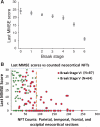"End-stage" neurofibrillary tangle pathology in preclinical Alzheimer's disease: fact or fiction?
- PMID: 21471646
- PMCID: PMC3171001
- DOI: 10.3233/JAD-2011-101980
"End-stage" neurofibrillary tangle pathology in preclinical Alzheimer's disease: fact or fiction?
Abstract
Among individuals who were cognitively intact before death, autopsies may reveal some Alzheimer's disease-type pathology. The presence of end-stage pathology in cognitively intact persons would support the hypothesis that pathological markers are epiphenomena. We assessed advanced neurofibrillary (Braak stages V and VI) pathology focusing on nondemented individuals. Data from the National Alzheimer's Coordinating Center database (n = 4,690 included initially) and from the Nun Study (n = 526 included initially) were analyzed, with antemortem information about global cognition and careful postmortem studies available from each case. Global cognition (final Mini-Mental State Examination scores (MMSE) and clinical 'dementia' status) was correlated with neuropathology, including the severity of neurofibrillary pathology (Braak stages and neurofibrillary tangle counts in cerebral neocortex). Analyses support three major findings: 1. Braak stage V cases and Braak VI cases are significantly different from each other in terms of associated antemortem cognition; 2. There is an appreciable range of pathology within the category of Braak stage VI based on tangle counts such that brains with the most neurofibrillary tangles in neocortex always had profound antemortem cognitive impairment; and 3. There was no nondemented case with final MMSE score of 30 within a year of life and Braak stage VI pathology. It may be inappropriate to combine Braak stages V and VI cases, particularly in patients with early cognitive dysfunction, since the two pathological stages appear to differ dramatically in terms of both pathological severity and antemortem cognitive status. There is no documented example of truly end-stage neurofibrillary pathology coexisting with intact cognition.
Figures



References
-
- Consensus recommendations for the postmortem diagnosis of Alzheimer's disease. The National Institute on Aging, and Reagan Institute Working Group on Diagnostic Criteria for the Neuropathological Assessment of Alzheimer's Disease. Neurobiol Aging. 1997;18:S1–S2. - PubMed
-
- Arriagada PV, Growdon JH, Hedley-Whyte ET, Hyman BT. Neurofibrillary tangles but not senile plaques parallel duration and severity of Alzheimer's disease. Neurology. 1992;42:631–639. - PubMed
-
- Sonnen JA, Larson EB, Crane PK, Haneuse S, Li G, Schellenberg GD, Craft S, Leverenz JB, Montine TJ. Pathological correlates of dementia in a longitudinal, population-based sample of aging. Ann Neurol. 2007;62:406–413. - PubMed
-
- Nelson PT, Abner EL, Schmitt FA, Kryscio RJ, Jicha GA, Smith CD, Davis DG, Poduska JW, Patel E, Mendiondo MS, Markesbery WR. Modeling the association between 43 different clinical and pathological variables and the severity of cognitive impairment in a large autopsy cohort of elderly persons. Brain Pathol. 2010;20:66–79. - PMC - PubMed
-
- Berg L, McKeel DW, Jr, Miller JP, Storandt M, Rubin EH, Morris JC, Baty J, Coats M, Norton J, Goate AM, Price JL, Gearing M, Mirra SS, Saunders AM. Clinicopathologic studies in cognitively healthy aging and Alzheimer's disease: relation of histologic markers to dementia severity, age, sex, and apolipoprotein E genotype. Arch Neurol. 1998;55:326–335. - PubMed
Publication types
MeSH terms
Grants and funding
LinkOut - more resources
Full Text Sources
Medical

